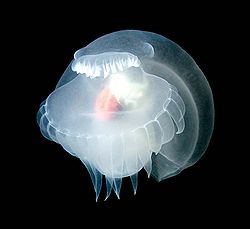
- Kingdom: Animalia
- Phylum: Mollusca
| Mollusk |
|---|
 |
| Scientific Classification |
|
| Class |
Mollusks are organisms belonging to the phylum Mollusca, which is the largest taxonomic phylum with the exception of Arthropoda. It includes snails, clams, conches, octopuses, squids, and pearly nautiluses. The term mollusca comes from a Latin word molluscus, meaning 'tender'. There are about 112,000 species within this phylum. Most live in the sea or in freshwater, but some live on ground. Approximately 80% of mollusks are smaller than 5m, but some have 15m bodies, such as Architeuthis harveyi. There is great variety within this invertebrate phylum, including creatures both with and without shells. [1]
Most have a shell and some are degenerated. Some eat grass, others eat meat, the others eat dregs in water.
Most Gastropods have a single, spiral shaped shell. In many cases the height of the shell is about the height of limpets. Marine Gastropods have a cover over the hole on their shell to act as protection.
Bivalves have two shells that are joined by ligament. They can open and close these shells. The head is very small and axe-shaped, with a big foot on its side.
Cephalopods are the biggest and the most active mollusks. While the Nautilus have shells, Cephalopods don't have any shell or only one shell on their bodies. Cuttlefishes have eight short feet and two long tentacles. Sometimes, the long one can be up to about 12m. With their streamline shape, they can swim quickly. Octopods don't have endoskeletons. They are soft, round, and have eight identical long legs.
Caudofoveata and Solenogastres seem like bugs and are without shells.
Polyplacophorans have eight shells which overlap each other under the muscular tissue.
It was previously thought that Monoplacophorans had all become extinct. However, one of them called Neopilina galatheae has been found alive. It has one 4cm-long shell and one wide flat foot.[2]
Classes Caudofoveata, Solenogsters, Polyplacophora, Monoplacophora, Scaphopoda, Gastropoda, and Bivalvia are characterized by dioecism (male and female in separate organisms). Usually, the male and the female spread sperm and egg cells into water for external fertilization. Alternatively, sperm flows with a water current to the female and internal fertilization takes place. The cleavage is spiral cleavage and determinate cleavage.
Gastropods live in the sea, fresh water, and ground. They have a tongue-like radula and use radula to feed on algae, seaweeds, organic accumulation, and rotten meat. Most of them eat meat. Bivalves live in the sea and fresh water. They eat minute planktons by their gills. Cephalopods live under the sea or rock. They eat crabs, fishes, bivalves, and even other squids. Caudofoveata and Solenogastres live under 18~4,000m deep mud and feed on oceanic life. Some species dig caves and eat microbes in the mud. Another species, which lives on oceanic life, take nourishment from the host. Polyplacophorans usually live on rock in the intertidal zone, but one of the Polyplacophorans is found under 4000m deep water. Scaphopods live in mud or sand and they can live under 5000m deep water. Threads from their heads can catch small organisms. [3]
Snail
Class: Gastropoda
Chiton
Class: Polyplacophora
Caribbean reef squid
(Sepioteuthis sepioidea)
Class: Cephalopoda
Nautilus
Class: Cephalopoda
|
||||||||||||||||||||